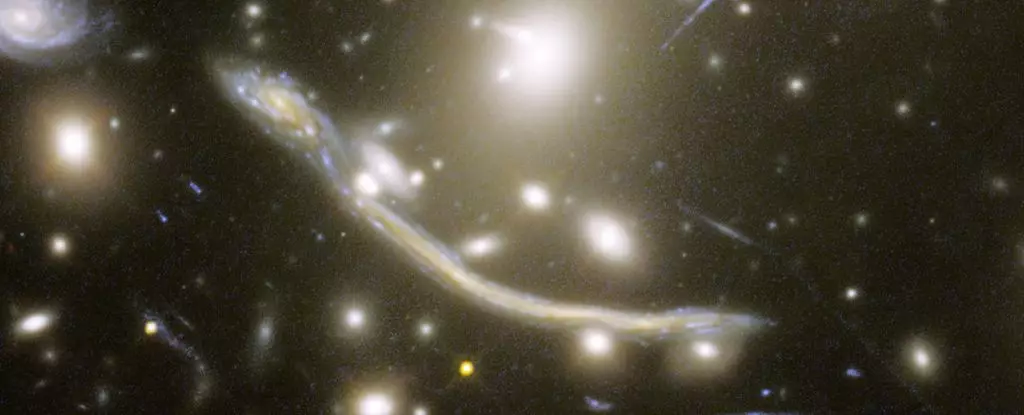The vastness of the cosmos is both awe-inspiring and daunting, particularly when we attempt to gaze back into the depths of time, observing the early stages of the universe. The challenge lies in the immense distances that light must travel, stretching billions of light-years to reach our telescopes. Generally, objects in the universe—especially stars from faraway galaxies—are too faint or too small to be seen individually. Yet, a seismic shift has occurred with the advent of the James Webb Space Telescope (JWST), pushing beyond the boundaries of what was once thought possible in astrophysical research.
Before JWST, the Hubble Space Telescope achieved remarkable feats, resolving only a handful of individual stars in distant galaxies. However, its capabilities were overshadowed by the technological advancements of the JWST, which has managed to distinguish over 40 individual stars in a galaxy where light traveled nearly 6.5 billion years to reach our planet. Leading astrophysicist Fengwu Sun from the University of Arizona emphasized the significance of this breakthrough by stating that it allows astronomers to conduct robust studies on individual stars in a distant galaxy—a feat that was unattainable before. This leap not only enhances our understanding of stellar evolution but also holds implications for the study of dark matter in the lensing plane—further elucidating the makeup of our universe.
The limitations of previous observations stemmed from our inability to discern individual stars amid the cosmic backdrop. The phenomenon of gravitational lensing, described by Einstein’s general relativity, plays an essential role in this endeavor. Gravitational lensing occurs when the space-time fabric surrounding large celestial bodies, such as galaxy clusters, warps and alters the path of light, creating multiple distorted images of a single object. This phenomenon has allowed astronomers to observe what we now refer to as the “Dragon Arc,” a stunning visual formation characterized by separate images of a distant spiral galaxy.
The Dragon Arc is a striking example of how massive clusters of galaxies—like the Abell 370—can manipulate the light of distant objects. Situated about 4 billion light-years away, this cluster creates a surreal tapestry of light in the night sky through its gravitational influence. Although the light appears distorted, astronomers employ sophisticated techniques to “reverse-engineer” this effect, reconstructing the original image of the background galaxies while taking advantage of the magnification it provides.
Yet, the excitement does not end with the gravitational lensing patterns alone. Within the Abell 370 cluster, astronomers have encountered isolated stars, each providing its own lensing contribution through a process known as microlensing. A Japanese team of astronomers, led by Yoshinobu Fudamoto, executed a targeted investigation to identify a distant galaxy’s light that was magnified by the gravitational pull of this cluster. Instead, they stumbled upon something even more extraordinary: 44 individual stars in the Dragon Arc’s hazy light.
What makes this discovery particularly intriguing is the nature of the stars identified—essentially, they are red supergiants, nearing the end of their life cycles. Unlike the blue and white giants typically discerned through large interstellar distances, these cooler, redder stars provide crucial insights into stellar evolution. The implications of studying such stars extend to our comprehension of galactic formation and the lifecycle of celestial bodies across time. The JWST has demonstrated a unique ability to observe red light, making it a formidable tool for illuminating objects that would otherwise remain hidden to other telescopes.
Understanding these red supergiants not only expands our knowledge of stellar populations in distant galaxies but also enables us to weave a richer narrative of cosmic evolution. As we anticipate further JWST observations, it is likely that many more stars will emerge from the blurred light of the Dragon Arc, providing additional data that will help astronomers piece together the intricate puzzle of the universe’s distant past.
The James Webb Space Telescope represents a transformative period in astrophysics, challenging our previous understandings and unveiling new cosmic vistas. Each observation not only deepens our comprehension of individual stars but also informs our understanding of broader cosmic phenomena like dark matter and galaxy evolution. As we continue to explore the universe with this exceptional tool, we are reminded that our search for knowledge is as boundless as the cosmos itself, filled with mysteries waiting to be unraveled.


Leave a Reply